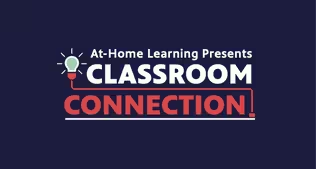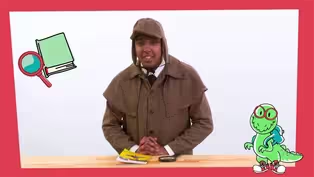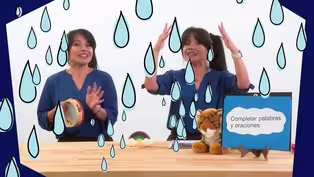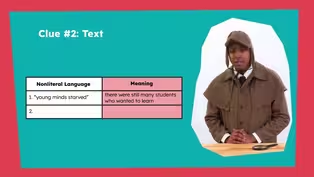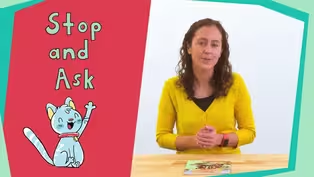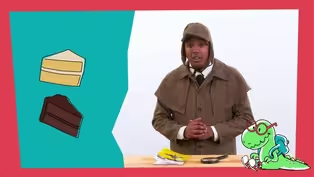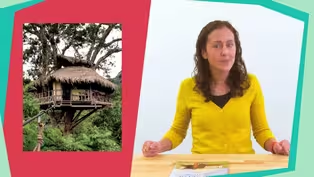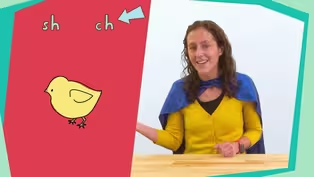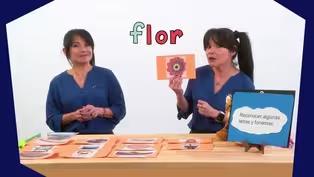
Episode 6 | Literacy Lessons
2/16/2021 | 28m 46sVideo has Closed Captions
Literacy lessons for early learners, led by NC teachers.
The first lesson is aimed at 3rd graders and helps build vocabulary development and reading comprehension by exploring multiple-meaning words. The second lesson (aimed at 1st-2nd graders) teaches learners what happens when two vowels are together. Classroom Connection is your At-Home Learning companion where children love to learn. All lessons are led by NC educators.
Problems playing video? | Closed Captioning Feedback
Problems playing video? | Closed Captioning Feedback
At-Home Learning Presents: Classroom Connection is a local public television program presented by PBS NC

Episode 6 | Literacy Lessons
2/16/2021 | 28m 46sVideo has Closed Captions
The first lesson is aimed at 3rd graders and helps build vocabulary development and reading comprehension by exploring multiple-meaning words. The second lesson (aimed at 1st-2nd graders) teaches learners what happens when two vowels are together. Classroom Connection is your At-Home Learning companion where children love to learn. All lessons are led by NC educators.
Problems playing video? | Closed Captioning Feedback
How to Watch At-Home Learning Presents: Classroom Connection
At-Home Learning Presents: Classroom Connection is available to stream on pbs.org and the free PBS App, available on iPhone, Apple TV, Android TV, Android smartphones, Amazon Fire TV, Amazon Fire Tablet, Roku, Samsung Smart TV, and Vizio.
Providing Support for PBS.org
Learn Moreabout PBS online sponsorshipMore from This Collection
Video has Closed Captions
Literacy lessons for early learners, led by NC teachers. (28m 46s)
Video has Closed Captions
Literacy lessons for early learners, led by NC teachers. (28m 46s)
Video has Closed Captions
Literacy lessons for early learners, led by NC teachers. (28m 45s)
Video has Closed Captions
Literacy lessons for early learners, led by NC teachers. (28m 45s)
Video has Closed Captions
Literacy lessons for early learners, led by NC teachers. (28m 46s)
Video has Closed Captions
Literacy lessons for early learners, led by NC teachers. (28m 46s)
Video has Closed Captions
Literacy lessons for early learners, led by NC teachers. (28m 45s)
Video has Closed Captions
Short Description: Literacy lessons for early learners, led by NC teachers. (28m 45s)
Video has Closed Captions
Literacy lessons for early learners, led by NC teachers. (28m 45s)
Video has Closed Captions
Literacy lessons for early learners, led by NC teachers. (28m 45s)
Video has Closed Captions
Literacy lessons for early learners, led by NC teachers. (28m 45s)
Video has Closed Captions
Literacy lessons for early learners, led by NC teachers. (28m 45s)
Providing Support for PBS.org
Learn Moreabout PBS online sponsorship[cheerful upbeat music] ♪ - Welcome to "Classroom Connection."
I'm your host, Mr. R, and I'm also a teacher.
I hope you'll join me in the classroom as we learn from teachers all across this beautiful state of North Carolina.
- Hello everyone.
I'm Ms. Shannon, and I'm so glad you're back to keep exploring "Sun!
One in a Billion" with me today.
It was written by Stacy McAnulty and illustrated by Stevie Lewis.
[playful music] Last time, we learned some really interesting facts about the sun.
We also found out that in this book, the sun is really funny.
Hi sun.
"Sun!
One in a Billion" is an extremely unique and interesting genre because it combines imagination with information.
It has some elements of fiction and some elements of nonfiction so that we can learn lots of facts while also being entertained.
We've been word detectives as we've read this book, finding important words and figuring out what they mean.
Now we're going to continue exploring words, but this time a little bit differently.
It's helpful to read texts more than once, because each time we do, we understand them more deeply.
Today, we'll be looking at some deeper levels of words' meanings.
Have you ever noticed that there are some words and phrases that can mean more than one thing?
It can be so confusing.
For example, if I said this room is cool, do I mean this room is cool?
[relaxed disco music] Wow.
Or do I mean this room is cool?
Brr.
[playful music] Today, we're going to learn about words and phrases in this book that can mean more than one thing.
We're also going to figure out how to use them correctly.
Some words have a literal meaning and a figurative meaning.
A literal meaning is exactly what the word would mean.
Like cool means kind of cold.
So a literally cool room may have snow and ice.
A figurative meaning is one you can't take literally.
It uses the word in a different way to make it more interesting.
So a figuratively cool room may have lots of games and other fun stuff to do.
As we read, we're going to keep track of the multiple meaning words and phrases that we find using this chart.
We're going to think about their literal and figurative definitions.
Making charts like this helps us keep track of our thinking and gives us something to refer back to when we're reviewing our learning.
Now word detectives, you will help me complete this chart challenge to keep track of the words' different meanings.
Watch me add the first two words' meanings.
Then you can help me fill in the rest.
Are you up for the challenge?
All right, let's get started.
The author makes the first multiple meaning word easy to find because she writes both of its definitions at the start of the book, almost just like we would read in a dictionary.
Yes, I am a star.
Star: one, a massive and luminous ball of gas, full of energy; two, an outstandingly talented and popular performer.
I fit both definitions.
In fact, we can see in the picture that the sun is reading the two definitions of the word star out of the dictionary Let's look at the word star.
The sun tells us at the beginning that it fits both definitions.
A big ball of light and gas in outer space.
This is the literal meaning.
And a performer that others enjoy watching put on shows.
This is the figurative meaning.
I need to add those to my chart.
Next to the word star, I added the literal and the figurative meanings.
So the first word we find in this book that can mean more than one thing is star.
You might see stars up in the sky, or you may see someone that's famous being a star in a movie or show.
Now, watch me find one more multiple meaning word and add it to our chart before you help me with this chart challenge.
I'm going to read this page, and you try to spot the multiple meaning phrase.
Can you hang out for eight minutes?
That's how long it takes my light to reach earth.
Yep, I give you heat and light.
You are welcome.
I'm so important that earthlings should name a special day in my honor.
We can call it Sunday.
Oh, wait Did you see it?
It's hang out.
This page asks if we can hang out for eight minutes.
Hang out is a phrase that can mean more than one thing.
What it means in this book is spending some time in one place or with others, the figurative meaning.
The sun asks us if we can figuratively hang out or wait in one place while its light reaches earth.
Where do you like to hang out?
And who do you like to hang out with?
You may enjoy hanging out with people you like, or hanging out in a place you think is really great.
I like hanging out right here with my friend, the sun.
But hanging out can also mean that something is literally sticking out of something else.
For example, this dog's tongue is hanging out of its mouth.
This is the literal meaning.
Can you think of something you've seen literally hanging out of your own or someone else's pocket before?
I've seen small pieces of paper hanging out of my own pockets many times.
I can find both of those definitions of hang out in a dictionary.
When I look up that phrase, it says, "One, spend time relaxing or socializing informally, and two, protrude and hang loosely downwards."
So now we know that hanging out has a literal meaning, something's sticking out of something else, and a figurative meaning, spending some time in one place or with others.
Watch me add this information to our chart.
♪ Doo doo doo doo doo doo doo ♪ ♪ Doo doo doo doo doo doo ♪ ♪ Doo doo doo ♪ ♪ Doo doo doo doo doo doo doo ♪ - Now that you know how to do our chart challenge, it's your turn.
See if you can find the multiple meaning phrase on this page as I read it.
It has a literal meaning and a figurative meaning just like hanging out did.
And because I'm the center of our solar system, life revolves around me literally.
Look, they all go in the same direction.
And there's the sun and the planets going around.
Did you find revolve?
Great job.
We know that the planets revolve or spin around the sun.
So that's one meaning.
Put up one finger.
Can you make something revolve or circle around it?
[lighthearted music] Maybe you did something like this?
Revolve can also have another meaning.
If someone thinks everything should revolve around them, they think that they're the most important, even more important than everyone else.
Do you think it would be more fun to play with someone who thinks everything should revolve around them, or someone who doesn't?
Let's think it through.
This is Spot and this is Muffin.
Spots likes to tell Muffin what to do.
Spot says he's the most special dog, so he should always get to pick which games he plays with Muffin.
Muffin thinks they're both really important and that they should work together to find something they both want to play.
Which dog thinks everything revolves around them?
Yes, Spot thinks everything should revolve around him.
And so I don't think Muffin will want to play with him for very long, because he's not very considerate.
Just like the other words we've looked at today, we can find both definitions of revolve in a dictionary.
When I look revolve up, it says, "One, move in a circular orbit around, and two, treat as the most important point or element."
It's great to know that dictionaries can help us with both figurative and literal meanings if we need to look something up.
Now that you know both meanings of revolve, it's time to determine which is the literal and which is the figurative meaning.
Does revolve literally mean to move in a circle or to treat something as the most important?
[cheerful music] Right, to move in a circle is the literal meaning of revolve because we can actually revolve an object or move it in a circle.
So that means that the figurative meaning of revolve is to treat something as the most important.
So if I say that my life revolves around people I love, I'm using revolve figuratively to say that those people are the most important thing in my life, not that I'm running in a circle around them.
That would be silly.
Let's add this word to our chart.
Wow, word detectives, our chart is looking great.
We have found three multiple meaning words in our book.
So now it's time to review.
We'll use our chart to help us with these choice challenges.
Which kind of star would you find in outer space?
That's right.
You would find a literal star in outer space, or a big ball of bright light and gas.
You'd find a figurative star here on earth.
Someone that likes to perform for others.
For the next one, which picture shows us the figurative meaning of hanging out?
The people flying kites together or the papers sticking out of the folder?
Yes, the figurative one is the picture of people hanging out together.
Paper hanging out of the folder is the literal meaning of that phrase.
Now, show me what your would face look like if you had to spend time with a person who thinks the world revolves around them, meaning they think that they're more special and more important than you.
Yeah, I don't think it would be too much fun hanging out with someone that thinks everything should revolve around what they want to do.
That's the figurative meaning of revolve.
Now it's time for a movement challenge.
I want you to literally revolve something around something else near you.
That means you're going to move something in a circle around something else.
You can use your body or other objects.
Look, the sun's revolving around Spot and Muffin.
Where did that come from?
Your turn.
What did you choose to revolve?
Maybe you found a toy to revolve around a chair or a pencil to revolve around your arm.
There are so many possibilities.
Thank you for exploring words with me today.
In this lesson, we learned that some words and phrases can have both literal and figurative meanings.
And very often, words can mean more than one thing.
When you're reading and listening to texts, see how many multiple meaning words and phrases you can find.
Once you've found them, keep them in your mind and challenge yourself to see how often you can use them when you speak and write.
See you again soon.
[air whooshes] - I just read that kangaroos can't walk backwards.
Can you?
Don't try it now though, or you might miss this awesome literacy lesson.
[upbeat music] - Hello readers.
My name is Ms. Gary, and I'm so excited to be learning with you today.
Before we get started with our learning lesson, let's say hello with our welcome song.
[cat meows] ♪ Hello readers, hello readers ♪ ♪ How are you, how are you ♪ ♪ I'm so glad to see you ♪ ♪ I'm so glad to teach you ♪ ♪ Hello you, you, and you ♪ So let's take a look at this anchor chart.
These letters are called vowels.
Each one may make a short vowel sound and a long vowel sound.
So let's review our short and long vowel sounds.
So I love to move.
So we're gonna learn and review our long and short vowel sounds.
I'm gonna crouch down when I say a short vowel sound and stand up when I say a long vowel sound.
So let's do that together.
Stand up for me and get ready, readers.
Here comes the a, short a says a, and long a says ay.
Here comes e. The short e say eh.
And the long e says e. Next is i.
Short i, ih.
Long i, i.
Next is o.
The short o vowel sound says oh.
And the long vowel o says o.
And here's the u.
Short u says uh.
And the long u says u. Wow, readers, that was great.
We will find these vowels in every word that we read and write.
But in addition to knowing our long and short vowel letter sounds during each lesson, we're going to learn some special words.
The words have special names, and they're called heart words.
And we call these word heart words because we're practicing reading them so that we know them by heart, or so we won't have to sound them out.
To do this, we're going to create our very own heart word dictionary.
You're going to need two pieces of paper and something to write with.
While I grabbed mine, you go ahead and get yours.
[bright music] I'm back, readers, with my two pieces of paper and something to write with.
I grabbed a marker, but it's okay if you grabbed a pen or pencil or crayon.
[lighthearted music] So let's make our heart dictionary together.
I'm going to start by stacking my two pieces of paper on top of each other, just like this.
Now I'm going to fold them in half hamburger style, or the short way.
Wow, look at that, readers.
It's a book, but we're going to draw a heart on the cover of our heart word dictionary so that we know we're putting our heart words there.
Now we're ready, so let's read our first heart word.
Look at this word.
This is the word could.
Can you say could?
Good, now let's spell it.
C-O-U-L-D. Could.
Let's say it one more time.
Could.
Now we're going to write it on the first page of our heart word dictionary.
Let's write it.
C-O-U-L-D. Could.
And there's mine.
Great job.
Let's get ready for our second heart word.
Look at this word, readers.
This is the word away.
Can you say away?
Good.
Now let's spell it.
A-W-A-Y.
Away.
Let's say it one more time.
Away.
Now we're going to write this heart word on the second page of our heart word dictionary.
A-W-A-Y.
Away.
Great job, readers.
We're going to learn one more heart word for our dictionary.
Let's look at this word.
This is the word they.
Can you say they?
Good.
Now let's spell it.
T-H-E-Y.
They.
Let's say it one more time.
They.
Now we're gonna write our final heart word on the third page of our dictionary.
T-H-E-Y.
They.
Excellent work, readers.
Later today, you could share your heart word dictionary with someone you love, or show them how you read it.
In today's lesson, [cat meows] we're going to learn about how vowels work together on a team, and that some of the time, when vowels work together, side by side, only the first vowel says its letter name.
Like here.
So when two vowels go walking, the first one does the talking.
So to help us learn about how vowel teams work together in words, let's look at some of our most common vowel teams that we see in words.
Let's look at this vowel team.. Ea.
Listen to me say this word.
Beach.
Let's tap out the sounds we hear in the word beach.
Buh ee chuh.
What sound did you hear this vowel team say?
Normally, when we see the e and a, they say the sounds eh and ah separately, but together when we see them, sometimes they'll say the long sound ee.
So when two vowels are together, like e and a in the word beach, the first vowel is doing all of the talking.
So when I see ea together, what sound will it say?
Ee.
Can we build some more words that have the ea vowel team sound?
We put r at the beginning.
Let's read this word, reach.
What sound did you hear the ea say?
Ee, so this word is reach.
Now let's look at our next ea vowel team word.
The dr at the beginning of our word, that's a blend.
So when we read that sound, we're gonna go duh urr, and blend the sound together.
There's the ee, and our final sound is mm.
So when I read it together.
Duh urr ee mm.
Dream.
Now let's look at another pair of vowels that make the same ee sound.
Let's read this word.
This is the word keep.
I'll point to the letters, and you say the sounds with me as I point.
Kuh ee puh.
Keep.
The letter k makes the kuh sound.
The ee vowel team makes the long e sound.
And the p makes the puh sound.
The ee vowel team, when they're together, is going to say long e, ee.
Can you say that?
Good.
Let's look at our next word with our ee vowel team.
This is a digraph.
So when we see it, it goes th at the end of our word.
So let's read it together.
Tuh, ee, th.
Teeth.
This word is teeth.
The ee together make the long e sound.
Let's read one more.
My sl is a blend.
So when I read it, it'll sound like this.
Ss ull.
Let's read this word.
Ss ull ee puh.
Sleep.
That's the word.
Sleep.
So the ee together, that vowel team says ee.
Let's look at another vowel team.
This is the vowel team ai.
Together, they're going to make the long a sound, a.
Let's look at a couple of words that go with this vowel team.
This is the word rain.
Ruh ain.
And I can change that beginning sound out to truh.
And it will read train.
So we're gonna take a look at just a couple more words that go with the vowel teams ay, oa, and ie.
So let's look at our vowel team ay.
This vowel team, when they're together, they're going to say ay.
So let's build a word.
What word do we have?
This is the word play.
If I tapped out the sounds that the letters make in the word play, I would hear puh ull ay.
Play.
I can change my beginning sound with the sound duh, or the letter d, and make the word day.
So when we see this vowel team appear in words, most of the time, at the end of the word, it's going to make the long a sound.
Let's look at another one, readers.
This vowel team is the ie.
Do you remember what sound it says?
Good, it says the long i sound.
So let's sound out this word.
Lie, like it's not good to tell a lie.
So readers, good job decoding some of our words that have vowel teams in them.
You did an awesome job today learning about vowel teams, and how when two vowels are side by side, the first vowel almost always says the letter name.
So I hope you enjoyed this lesson today, and I'll see you again next time.
- Hey, friends, check out this amazing video I just found.
You're going to love it.
[contemplative music] - My name's Tahir Troublefield.
I'm from Durham, North Carolina.
I've been skateboarding for eight years.
What I like about skating is the fact that you can pretty much just be yourself.
It's freedom of expression and creation.
You do what you want to do, man.
You just kind of come out there and do your thing.
No matter what you do, it's great.
The skate scene out here is real dope.
I really love the skate scene in Durham, North Carolina.
It's like we're all really connected 'cause it's not that large, like Raleigh, like the capital, but you know what I mean?
We really hold it down for each other, for one another.
We got each other's backs out here.
Even after I'm 60, if I can still walk, run, skate, I'll still be skating.
- It's been another wonderful day.
And I'm so glad we got to spend it together.
Peace, love, and learning, homies.
[cheerful upbeat music] ♪
Support for PBS provided by:
At-Home Learning Presents: Classroom Connection is a local public television program presented by PBS NC
